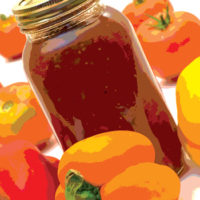High-Pressure Processing – Keeping Foods Fresh, Healthy, and Safer

Today’s consumers are looking for convenience, high nutritional value, additive free, natural, functional products, according to a recent report.[1] To meet these demands, food processors are looking to nonthermal technologies like high-pressure processing (HPP).
HPP is a United States Department of Agriculture-approved process for a variety of foods using safe, natural water pressure to eliminate potential pathogens and food spoilage organisms. Unlike thermal technologies—which can destroy vitamins and change flavors—HPP provides a solution for processors wanting to deliver fresher, healthier, safer options.
Research shows the global HPP food market to be worth $14 billion in 2018. By 2023, the market will reach an estimated $27.4 billion and will grow to $51.1 billion by 2027.[2] This growth is a result of many factors including consumer trends, food safety, and food industry demand.
One developing consumer trend is the clean label movement. More than ever before, consumers are focused on what they eat and drink, requesting detailed information about the ingredients that make up the products they buy and consume. Not only do consumers want fresh, convenient, and less processed foods and beverages, but they are willing to spend more money to receive these better-for-you products. Additionally, consumers, especially millennials, will research production methods before purchasing products.
Due to a desire to meet these consumer demands, and increased concern over food safety and the rise in foodborne illness, food manufacturers and retailers are seeking reliable food safety and preservation methods, like HPP, to help ensure the best product quality. They not only want to keep consumers safe, but they also want to protect their brand.
Both consumers and industry are also focused on food waste and sustainability. In the 2017 Nielsen Global Sustainability Survey,[3] 68 percent of Americans said it is important for companies to implement programs to improve the environment, 67 percent planned to prioritize healthy or socially conscious food purchases in 2018, and 48 percent said they would change their consumption habits to reduce environmental impact.
While food safety is still the number one reason for HPP, many manufacturers and retailers also cite shelf-life extension as a major benefit. Processors want to be responsible and make sure good food does not go to waste. Longer shelf life decreases a product’s chance of ending up in a landfill. Additionally, the longer a product lasts, the further it can be safely distributed and sold.
With HPP, high pressure is transmitted uniformly throughout the product rendering vegetative cells of both spoilage and pathogenic microorganisms inactive, which does not happen under traditional cooking and pasteurization methods. Processors can take innovation to a new level, giving products such as fresh juices a safe, extended shelf-life that would otherwise not be possible without the use of heat, additives and preservatives.
This extended shelf-life also comes with the benefits of improved food safety. Pressure inactivates yeast, molds, bacterial cells and most viruses. Improved food safety with minimal change in food flavor, color, texture, and nutritional value fulfill consumer’s desire for fresh-like characteristics. The effectiveness of the HPP process depends on the amount of pressure applied, vessel holding time, temperature, product type, and targeted pathogens and spoilage organisms.
The improved food quality delivered by HPP comes with fewer to no additives, and the added appeal of a clean label—providing food safety without additives or heat. The extended shelf-life, often two or three times longer than traditional processing methods, means higher yields for food processors, bringing improved profits and reduced waste.
HPP also opens up possibilities for food products that traditionally spoil under thermal treatment. For example, the technology allows processors to shuck mollusks or extract crustacean meat without boiling, producing higher yields, fresher flavors, and minimizing hand labor.
One of the most popular uses for HPP is for proteins, including roast beef, chicken, pork, and ground meats like turkey, chicken, and beef. Others include premium juices, dips, wet salads, dairy, and seafood as well as pet food.
Some of its newer applications are in the preservation of baby food, premium juices, plant-based protein drinks, cocktail mixers, nutrient dense shots, coffee and tea selections, and bone broth. Producers of ready-to-eat meats, dips, guacamole, salsa, and hummus often use HPP. Raw pet food, which has been affected by Salmonella and other pathogenic outbreaks recently, is also a growing market for HPP. Just like for their own food, pet owners are demanding fresh, nonprocessed foods for their pets. HPP is a proven means of creating a safe, clean-label, raw pet food.
The cost of HPP varies depending on the size of the production runs, fill efficiency of the product within the HPP vessel and process parameters. But these costs may be offset by other price reductions that HPP enables such as eliminating food additives. HPP also brings operational benefits such as lower energy usage as it only requires the use of water, which is recyclable and environmentally friendly.
The future of HPP in food production looks bright, with new uses continually being explored. As its awareness grows among manufacturers, retailers, and foodservice companies, and with additional education about its benefits coming from organizations such as the Cold Pressure Council, whose mission is to lead, facilitate and promote industry standardization, user education, and consumer awareness of HPP, more companies will embrace this technology as part of their food safety program. Additionally, they will consider HPP because of the extended shelf-life benefits. With consumer demand for fresh foods and beverages growing, HPP will lead the way in helping to produce fresh, safe food and beverage products for all to enjoy.
Maria Ferrante is senior director, marketing and communications, The Association for Packaging and Processing Technologies, producer of PACK EXPO.
References
1. pmmiprod3ebiz.personifycloud.com/PersonifyEbusiness/Store/2018-Snack-Foods-Packaging-and-Processing-Market-Assessment-and-Trends/ProductDetail/21787358.
2. www.asdreports.com/market-research-report-461534/high-pressure-processing-hpp-equipments-foods-market.
3. sites.nielsen.com/yearinreview/2017/global-responsibility.html.
Looking for a reprint of this article?
From high-res PDFs to custom plaques, order your copy today!







